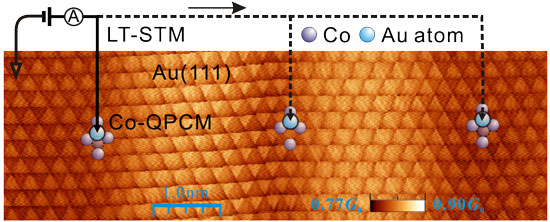| Posted: Aug 16, 2011 | |
Quantum point contact microscopy - a novel method for surface characterization |
|
| (Nanowerk Spotlight) The atomic structures of nanoscale contacts are not available in most experiments on quantum transport. Scanning tunneling microscopy (STM) operates at a tip-sample distance of a few angstroms and relies on probing a conductive surface in the evanescent tail of electronic states. By decreasing the tip-sample distance the sensitivity to chemical interactions can be enhanced. This has already been demonstrated in non-contact atomic force microscopy (AFM), where the oscillating tip comes for short periods of time within the range of chemical interactions. | |
| A team of scientists has now developed Quantum Point Contact Microscopy (QPCM) as a novel imaging mode of low-temperature STM (LT-STM), where instead of measuring a current through a tunneling junction, a transport current through a quantum point contact formed by a single atom between the STM tip and the surface is recorded. | |
| "Instead of working in the tunneling regime, quantum point contact microscopy works at conductance close to 1 G0, with an atomic sharp tip in contact to an adatom on the sample surface," Yong-hui Zhang from the Department of Physics at Tsinghua University in Beijing, explains to Nanowerk. "QPCM imaging can reveal more detailed information on surface structure than STM imaging. It complements tunneling measurements by an up-close picture, which is strongly influenced by the local atomic and chemical configuration of the topmost atomic layers." | |
| Zhang is first author of a paper in the July 26, 2011 edition of Nano Letters ("Quantum Point Contact Microscopy"), where he and Klaus Kern and Peter Wahl from the Max-Planck-Institute for Solid State Research in Stuttgart, Germany, introduce QPCM as a novel method for surface characterization. | |
| Although earlier this year, researchers presented experimental work ("Atomic-scale engineering of electrodes for single-molecule contacts") where the conductance of a C60 molecular junction was found to depend strongly on the atomic structure of one contact, here the atomic structure of one contact to the C60 is artificially fabricated by manipulation of single atoms in an LT-STM. Whereas in Zhang's work natural surface structures are used as one contact to the single atom. | |
 |
|
| QPCM imaging the gold (111) surface reconstruction with an single cobalt atom. (Image: Yong-hui Zhang, Tsinghua University) | |
| The researchers note that QPCM could be a promising experimental method for determining foreign surface structures or, when the surface properties of a sample are already known, it can provide a unique opportunity for studying the quantum transport in nanostructures at this conductance, where conductances measured at different surface positions can be directly related with their local surface structures. The high level of control of the single atomic contact facilitates an interpretation of QPCM images in terms of the local chemical environment of the contact atom. | |
| "Such detailed structural information on the nano contact is not available in most experiments without an STM," says Zhang. "Therefore I think our work could advance both surface studying methodology and nanoelectronics research." | |
| In their experiments the team succeeded in performing QPCM on Cu(111), Ag(111), Au(111), and Pt(111) surfaces despite significant differences between their diffusion barriers for adatoms. This underlines that the diffusion barrier for adatoms is significantly reduced by the presence of the tip. | |
| The researchers point out that, besides performing QPCM with single atoms at the contact between tip and surface, by using molecules it might be possible to adjust the contrast of QPCM images for specific characteristics of the surface such as local reactivity or selectivity of adsorption and binding sites. | |
| Zhang cautions that, although QPCM sees more than STM, it is still not straightforward to derive surface structures from the output results of QPCM. Ab-inito calculation of QPCM images could be helpful in determining surface structure from QPCM data. | |
| The other issue with QPCM is that so far this method has only been tested on metallic surface. Understanding of point contact on other conducting surfaces (e.g. semiconductor) is indispensable for extending QPCM to these surfaces. | |
 By
Michael
Berger
– Michael is author of three books by the Royal Society of Chemistry:
Nano-Society: Pushing the Boundaries of Technology,
Nanotechnology: The Future is Tiny, and
Nanoengineering: The Skills and Tools Making Technology Invisible
Copyright ©
Nanowerk LLC
By
Michael
Berger
– Michael is author of three books by the Royal Society of Chemistry:
Nano-Society: Pushing the Boundaries of Technology,
Nanotechnology: The Future is Tiny, and
Nanoengineering: The Skills and Tools Making Technology Invisible
Copyright ©
Nanowerk LLC
|
|
|
Become a Spotlight guest author! Join our large and growing group of guest contributors. Have you just published a scientific paper or have other exciting developments to share with the nanotechnology community? Here is how to publish on nanowerk.com. |
|
